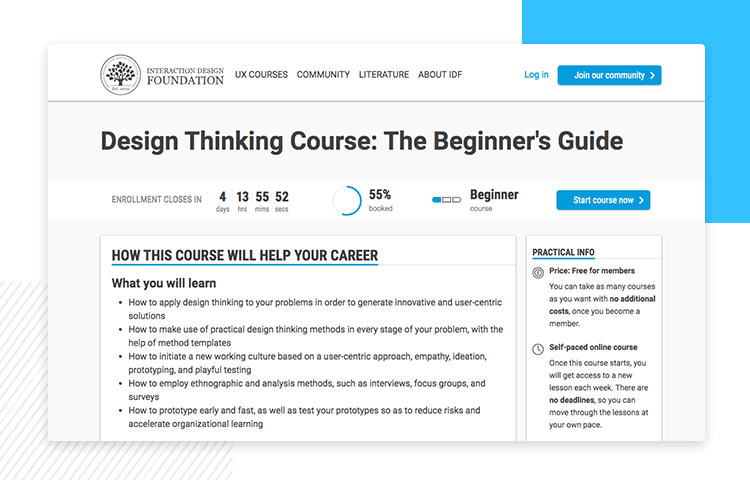Table Of Content
- What skills or experience do I need to already have before starting to learn about design thinking?
- Apple iPhone iPad Mac Users Abruptly Locked Out Of Devices Reset Required
- Core Competencies
- Design Thinking and Creativity for Innovation by University of Queensland (edX)
- Teaching Team
- Cooper Professional Education’s Cooper Crash Course: Design Thinking in 3 Steps

Design thinking is a way of thinking, acting, and interacting that opens a new world of problem-solving possibilities and helps you create new and innovative products, services, and processes. By helping you stay focused on the people you’re serving, by encouraging you to seek out and consider diverse perspectives, and by allowing you to hush your inner critic. Participate in monthly “Activation Hours” where you’ll join our program instructors live, as they walk you through new, supplemental creativity and design thinking content. In the discussion sessions, you will meet and collaborate with your fellow learners.
What skills or experience do I need to already have before starting to learn about design thinking?
This Course has been developed by the Batten Institute for Entrepreneurship and Innovation at the University of Virginia’s Darden School of Business. It is intended for those who work in a nonprofit or in the social sector and are seeking insights into successful methods for understanding and solving problems that the society faces today. Often times organizations in social services struggle to meet the needs of the people they serve and are not able to bring out the new and innovative solutions needed to solve tough problems.
Apple iPhone iPad Mac Users Abruptly Locked Out Of Devices Reset Required
They are taught various structured models and techniques that help them to be an innovator and change-maker in any industry. This course will teach you fundamental principles of design and how to effectively evaluate your work with users. You'll learn fundamental principles of visual design so that you can effectively organize and present information with your interfaces. You'll learn principles of perception and cognition that inform effective interaction design. And you'll learn how to perform and analyze controlled experiments online. A lot of the examples will come from the Web, and we'll talk just a bit about Web technologies in particular.
Core Competencies
Insights from the testing phase can require returning to a previous step, redefining the problem, or creating a different solution. The iterative process prompts design thinkers to anticipate more problems that need to be solved, which helps users with problems that they may not even realize exist. View and complete course materials, video lectures, assignments and exams, at your own pace. You also get 60 days of email access to your Stanford teaching assistant.
What Happens When Kids Get a Crash Course in Design Thinking - Stanford Graduate School of Business
What Happens When Kids Get a Crash Course in Design Thinking.
Posted: Fri, 26 Aug 2022 07:00:00 GMT [source]
Past boot camps have been offered in Atlanta, Boston, San Francisco and Washington, DC. Enables personalizing ads based on user data and interactions, allowing for more relevant advertising experiences across Google services. You will get a digital industry-recognized course certificate every time you complete a course. Certificates never expire and can be saved as a .jpg file, so it's easy to be shared. Also, there is no limit to how many certificates you can earn during your membership. Join Join Jeff Speck, author of the best-selling Walkable City, for a comprehensive two-day course on the most effective arguments, techniques, and tools for reshaping places in support of walking, biking, and transit.
International business, UPS Design Thinking project spurs business innovation - University of South Carolina
International business, UPS Design Thinking project spurs business innovation.
Posted: Thu, 10 Feb 2022 08:00:00 GMT [source]
In this course, Jeremy Utley and Justin Ferrell will introduce you to design thinking, as they teach it every day here at the Stanford d.School. It will help you get started in your design thinking journey and will prepare you for further, more hands-on courses. Dr. Kathryn Segovia of the Stanford d.school will guide you through a series of coaching lessons between each course that will help you build your daily creative practice and form a lifelong routine that fosters innovation. Jeremy Utley and Justin Ferrell will introduce you to design thinking, as they teach it every day here at the Stanford d.School. Get started in your design thinking journey and prepare for further, more hands-on courses.
Specialization - 4 course series
You'll learn how to generate design ideas, techniques for quickly prototyping them, and how to use prototypes to get feedback from other stakeholders like your teammates, clients, and users. You'll also learn principles of visual design, perception, and cognition that inform effective interaction design. Within the BA Product Design programme, this happens through activities such as projects, workshops, reports and set exercises both within taught sessions, and as independent work. The Final Major Project is self-initiated and self-directed, taking place over an extended period of time across the academic year.
Foundations in Design Thinking Certificate (IDEO U)

Your course group will be made up of an incredibly diverse group of professionals, all of whom have the same objective—to become successful designers. It’s your chance to learn, grow, and network with your peers across the planet. Design Thinking and Innovation from Harvard Business School (HBS) Online will teach you how to leverage fundamental design thinking principles and innovative problem-solving tools to address business challenges.
Cooper Professional Education’s Cooper Crash Course: Design Thinking in 3 Steps
The module develops students’ understanding of reverse engineering, mass manufacture design requirements and related design optimisation techniques. This module provides the opportunity for you to develop your design knowledge, practice and experiences and to apply their design skills through workshops and selected external collaborative projects covering a range of sectors. You will focus on deepening theory, process and contextual knowledge, and applying that knowledge in responding to complex briefs. The focus of the module is on developing both an intellectual awareness and a practical application of design process methods, ideas generation and communication techniques and creative conversations.
This course shares such stories to illustrate how collaborative creativity helps even the most entrenched bureaucracies arrive at innovative solutions. It helps managers understand why adding design thinking to their organizations toolkit is highly important for success. Another great choice for mastering Design Thinking is Rochester Institute of Technology’s Design Thinking Micromasters program on edX. This program has an immersive curriculum that aims to teach participants how to be creative, collaborative and emotionally intelligent in pursuit of problem-solving expertise. It equips them with knowledge of the processes and techniques used to solve problems and innovate in the workplace.
But what if you’re already a design thinking expert—do you still need a certification? Even if you’re already incorporating design thinking into your work, an official certification will help to verify your knowledge and present it as a concrete skill. By definition, design thinking is both an ideology and a process used to solve highly complex problems in a user-centric way. So, not only is it a mindset that encourages you to put your users first; it is also a practical, actionable methodology that can be applied in almost any setting. Led by two instructors from UC Berkeley’s Haas School of Business, this six-week online course is distributed via Knowdeon. Guest speakers include Elizabeth Glenewinkel, director of strategic innovation at Salesforce.
Participants will walk away with an innovation toolkit of frameworks and exercises for identifying business opportunities and generating possible solutions for their organization’s initiatives. Design thinking methods and strategies belong at every level of the design process. However, design thinking is not an exclusive property of designers—all great innovators in literature, art, music, science, engineering, and business have practiced it. Now we will dive deeper into the design thinking process, looking at how we can use it to generate better ideas. Examining what already exists is the first step in the design thinking process. As part of assessing "what is?", designers “follow the customer home” and explore the problems they are trying to solve in life versus their product use.
In this course, you will learn relevant fundamentals of human motor performance, perception, and cognition that inform effective interaction design. You will use these models of how people work to design more effective input and interaction techniques. The first year is graded as pass/fail (with extensive feedback), providing a supportive learning environment that supports exploration, experimentation, taking risks and making mistakes as a core component of design practice. Participants are expected to devote 8-12 hours per week to the program, and in order to get the final certification, will need to earn a verified certificate in all five courses successfully. The program consists of online workshops, an online course that is the equivalent of a 3-credit university course, and two live meetings.
If your employer has contracted with HBS Online for participation in a program, or if you elect to enroll in the undergraduate credit option of the Credential of Readiness (CORe) program, note that policies for these options may differ. The applications vary slightly from program to program, but all ask for some personal background information. If you are new to HBS Online, you will be required to set up an account before starting an application for the program of your choice. We expect to offer our courses in additional languages in the future but, at this time, HBS Online can only be provided in English. IBM is currently offering all of their courses and toolkit activities for free.

No comments:
Post a Comment